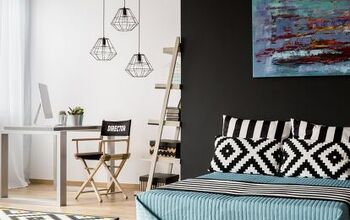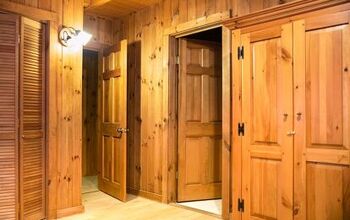How To Pick A Room For A Home Office

Countless people work from home now, and it’s become a normal part of life for many homeowners. However, figuring out which room will double as your home office is easier said than done in many cases. That’s why you may understandably struggle with how to pick a room for a home office.
Prioritize natural light when you pick a room for a home office and look for south-facing windows. It’s also essential to pick a well-insulated room, so you feel comfortable while working from home. Ideally, you should pick a room in a corner of your home without much foot traffic to reduce noise.
It’s hard for some people to justify giving up a room to use as a home office. In that case, you may need to set up space in a room that you use for another purpose. Follow along as we explore how to pick a room for a home office.
How To Choose A Home Office
1. Think About Natural Light
Natural light does wonders for mental health and concentration, which are important when working from home. Prioritize natural light when you pick a room for a home office to start on the right foot. Look for a room with at least one window that will let the sun in for most of the day.
South-facing windows are especially useful, as they let the most sun in for those living in the northern hemisphere. It’s also a great idea to choose light-colored paint to reflect as much natural light as possible. Avoid covering your windows or use sheer curtains that won’t dampen the light too much.
You can use several methods to boost natural light at home if you don’t have many windows to work with. For example, you can install a sky tunnel and position mirrors to reflect light throughout your home. Otherwise, you can uncover your windows and clear the shrubs in front of them to maximize light.
2. Prioritize Comfort
The location of your home office has a lot to do with your comfort. That’s especially true when it comes to temperature and ventilation. For example, rooms with exterior walls and poor insulation are often cold in winter and hot in summer.
While some people don’t mind that, many homeowners may struggle to focus in their cold or hot home office. You also risk feeling cold in your home office if it sits above the garage. Try to pick a room that is well-insulated and has good airflow.
However, depending on your home’s layout, that may not be an option. In that case, you may want to use a space heater throughout winter to stay warm in your home office. Make sure to plug it into a dedicated outlet, or else you may blow a fuse.
3. Minimize Noise
It can be hard to find a quiet space at home, especially if you have a large family or roommates. However, noise and distractions aren’t conducive to a working environment. That’s why it’s important to find a room without much nearby foot traffic and noise.
For example, a room off a main hallway is likely to be loud, as it will get a lot of foot traffic. Rooms near common areas, like kitchens and living rooms are also typically loud. If possible, set up a home office in a corner of your home that’s away from common areas.
It also helps to set some rules for your family and roommates when working from home. For example, you can establish a “quiet time” during your working hours. Otherwise, you can request that people be considerate with their conversations and footsteps as you work.
4. Consider How Much Space You Need
It’s all too easy to see a room and quickly assume it would be a perfect home office. However, there’s no way to know until you put all your belongings in there. Office supplies, like computers, printers, copiers, and a desk and chair take up a lot of space.
It’s a great idea to measure your desk and office supplies and compare them to the dimensions of your potential office. This will tell you whether or not everything will fit. Keep in mind that you should try to pick a room with a little more space than you need.
That way, you can account for new supplies and furniture that you may bring into your office one day. This will also give you some space to stretch and pace around as needed. The roomier your home office is, the more comfortable it will be.
5. Pick A Room That Can Be Repurposed
The hardest part of choosing a room for a home office is finding one you can justify repurposing. That’s especially true if your home has limited space without many storage options. You must pick a room with items that you can reasonably store in other spots.
This is unnecessary for some homeowners as they may have spare rooms in their homes. Otherwise, you must pack what you have in the room and spread it among other rooms in your house. Some people even leave the room as is and set up office supplies among their other belongings.
That is a great option as well, as long as you don’t feel cramped and overwhelmed. Inspect all the rooms in your house and identify which one is the least essential. If you don’t have a spare room, you can set up a small desk and computer in an existing room and make it work.
6. Aesthetic Potential
While a home office doesn't need to look groundbreaking, they should at least feel personal. You can make your time working from home much easier if you enjoy your home office. That’s why it’s a great idea to pick a home office with aesthetic potential.
Decorating your home office can make you feel more comfortable during work hours. This can work wonders to boost your spirit and make you feel better about your work. You don’t need to go all out and spend a fortune decorating.
However, it’s worth at least setting up art and decorations that make you happy. Plants can also boost your mood and add life to your home office.
Should Your Home Office Be In Your Bedroom?
It’s often recommended to keep your home office and bedroom separate. Otherwise, you may constantly think about work in your bedroom even when you’re going to sleep or relaxing. This can make it hard to escape the stresses of work.
Not only can this cause sleep problems, but it can significantly contribute to stress. Stress and poor sleep habits can contribute to many health problems, such as obesity. The last thing you want to do is affect your overall health because of where you put your home office.
Keep in mind that some people don’t have space to put their home offices anywhere besides their bedrooms. In that case, you must do whatever you can to decompress after a long day of work. That way, you won’t struggle to go to sleep because you feel like you’re stuck in your office.
Summing It Up
Pick a home office with lots of natural light to maintain focus and boost your mood when you work from home. Ideally, you should choose a room without much nearby foot traffic to minimize noise in your home office. Make sure you pick a room with enough space for your furniture and office supplies, so you don’t feel cramped.
Related Guides:

Nick Durante is a professional writer with a primary focus on home improvement. When he is not writing about home improvement or taking on projects around the house, he likes to read and create art. He is always looking towards the newest trends in home improvement.
More by Nick Durante













![Finishing Basement Without Permit [Is It Really Illegal?]](https://cdn-fastly.upgradedhome.com/media/2023/07/31/9070078/finishing-basement-without-permit-is-it-really-illegal.jpg?size=350x220)













